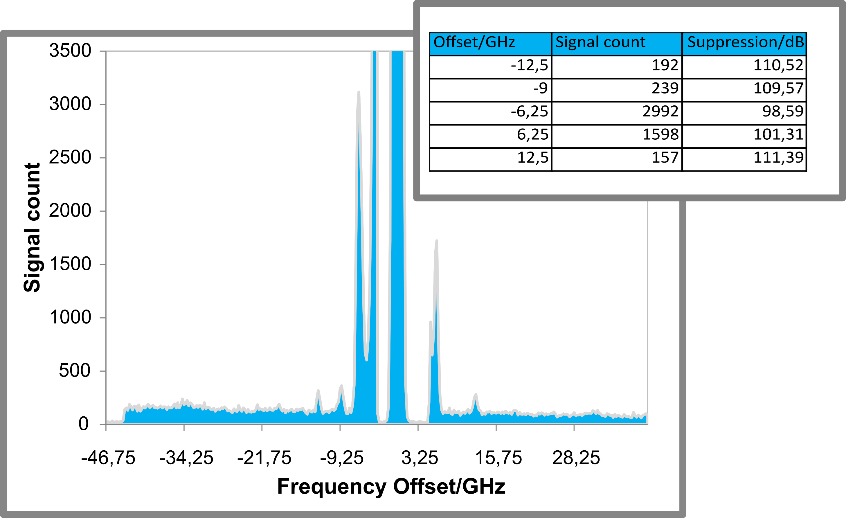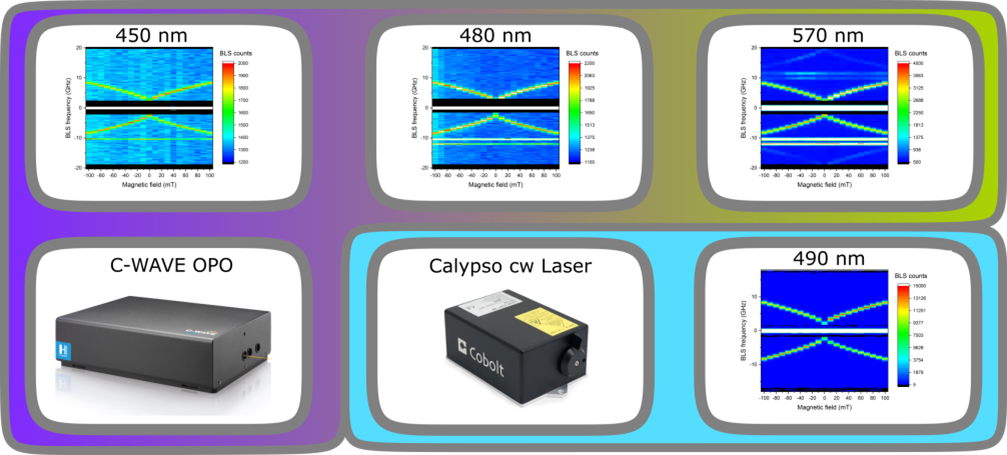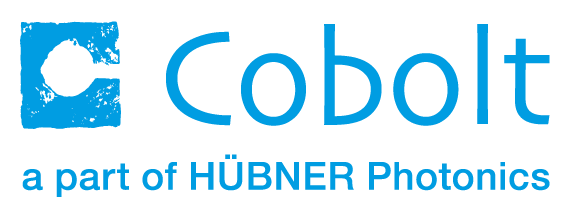Lasers for Brillouin Light Scattering Spectroscopy
Narrow Linewidth Lasers for Brillouin Scattering Spectroscopy
Nonlinear spectroscopy technologies have proven their potential as powerful tools in material sciences. Raman spectroscopy is today without a doubt among one of the most standard material characterization methods for analysis of crystalline materials. As magnetic materials gain increased importance for information technology, the characterization of spin waves is moving into the focus of scientists. In this case, the magnetic properties of such materials are especially of interest and Brillouin light scattering spectroscopy (BLS) [1] is then the prefect technique to investigate with.
Background
Nonlinear optical effects are exploited in a wide range of technologies. In particular, two common nonlinear inelastic scattering methods, Raman and Brillouin scattering, both give important insight into the physical properties of the material under investigation. While Raman spectroscopy reveals the structure or chemical composition, Brillouin spectroscopy provides information on a larger scale such as the elastic or magnetic properties. Although the physical processes of both can be compared up to a certain degree, the big difference is that the Brillouin signal lies in the GHz region and the Raman signal in the THz region in relation to the incident laser light. This puts even higher demands on the spectral purity and linewidth of the incident laser light in order to reveal the very weak Brillouin signal, when compared with Raman spectroscopy.
In this post, we discuss the laser characteristics needed for Brillouin spectroscopy and show that this technique can be used to characterize the magnetic properties of ferromagnetic thin films. These are used in spintronics and magnonics, new approaches to use magnetic effects in computing to overcome limitations of the current CMOS (Complementary Metal Oxide Semiconductor) architecture [2]. Both fields of research promise to play important roles in future generations of computation devices.
Characterization of laser sources for Brillouin scattering
The term Brillouin light scattering refers to the nonlinear optical creation of an acoustic phonon or a magnon [3]. The resulting photon to phonon/magnon interaction results in a very weak Brillouin signal typically in the low frequency GHz region in relation to the incident laser light. In order to expose the resulting weak Brillouin signals, the laser line must have typically better than 70 dB side mode suppression, and in some cases as good as 100 dB. In addition, the linewidth of the laser must be very narrow (<1 MHz) so that the GHz Brillouin signals are not swamped by the incident laser line.
For the measurement in this application note, a fixed wavelength, single frequency (<1 MHz) diode pumped laser with spectral purity >70 dB and 200 mW output power was used (Cobolt Calypso 491 nm). The wavelength and power level is well suited for spectroscopy of magnons in metallic ferromagnets such as permalloy.
In contrast to the fixed wavelength laser above, a tunable source of cw laser light was also used to investigate how the Brillouin signals varied with wavelength. The tunable laser light source (C-WAVE) is based on Optical Parametric Oscillator (OPO) technology [4]. The output has a broad tunable range between 450 nm and 750 nm providing up to Watt power levels and operates single frequency (<1 MHz) with exceptional spectral purity (>100 dB).
Due to the very weak low frequency Brillouin signals an especially sensitive high resolution Tandem Fabry-Pérot interferometer is typically used (see [5] for details). By placing a mirror in the sample position and using adequate ND filters to suppress the laser line, such an interferometer can be used to analyze the emission spectrum of lasers. Figure 1 shows the spectrum of the tunable laser light source, C-WAVE. The strong laser line is shown at 0 GHz and the size of the peak is 10 orders of magnitude higher than the scale shows. The data shows that the side modes are suppressed to the order of >98 dB. While the fixed wavelength diode pumped Cobolt Calypso 491 nm has a side mode suppression of approx. 70 dB, both laser sources are well suitable for BLS spectroscopy, as can be seen in the following example.

Figure 1: Frequency resolved optical power of the C-WAVE OPO with a central wavelength of 457 nm. While the side modes are resolved, the main mode is more than 98 dB stronger than the strongest side mode 6.25 GHz away and is outside of the graph scale by more than 10 orders of magnitude.
Brillouin light spectroscopy (BLS) measurements
As permalloy is one of the most promising candidates for spintronic and magnonic devices, we have looked at its BLS spectral properties of magnetic excitations. The sample used for the measurements presented here is a 5 nm thick permalloy film sputtered on Si/SiOx capped with a thin aluminum layer to prevent oxidation. The laser sources used are described previously. The C-WAVE tunable OPO output wavelength was set to 450 nm, 480 nm, and 570 nm. The sample was exposed to a magnetic field with variable field strength of up to 100 mT to measure the field dependent BLS spectra. It is worth noting that the Tandem Interferometer setup is optimized for an operation wavelength of 491 nm. At excitation wavelengths that are further away from this value, the measurement signal experiences some additional unwanted damping caused by wavelength filters and dielectric mirrors.
Figure 2 shows the BLS signal power in arbitrary units as colormap over the strength of the applied magnetic field (x axis), as well as the frequency offset to the excitation frequency, which equals the magnon frequency of the excited BLS magnon (y axis). The broad, clear BLS signal shows in all of the graphs as green wings despite the fact that the frequency offset to the strong excitation signal is less than 10 GHz and at low magnetic field strengths even in the range of 1 GHz. The observed mode is closely related to the usual Kittel mode behavior in ferromagnetic resonance measurement.

Figure 2: BLS spectra measurements of permalloy are shown using the C-WAVE tuneable OPO source at wavelengths 450 nm, 480 nm and 570 nm (top row) and the Cobolt 05-01 Calypso diode pumped laser at 490 nm (bottom right). The BLS signal is shown as a colour map over the strength of the applied magnetic field (x axis), as well as the frequency offset to the excitation frequency, which equals the magnon frequency of the excited BLS magnon (y axis). The BLS signal shows clearly as green wings. The measurements taken with a distance to the spectrometers’ design wavelength of 490 nm collect some extra noise.
Outlook
We have successfully demonstrated that the fixed wavelength diode pumped Cobolt Calypso laser at 491 nm as well as the cw single frequency tunable light source C-WAVE, are suited to the demanding technique of Brillouin spectroscopy. We have used a Tandem Fabry-Pérot Interferometer to measure the spectral purity and show high side mode suppression of more than 70 dB and 98 dB respectively, and along with the narrow linewidth and high output powers this means that the low frequency Brillouin signals can be readily distinguished. While the C-WAVE tunable laser proves superior to the Cobolt Calypso 491 nm regarding the spectral purity, both lasers show very good behavior in this respect and are perfectly suited for BLS spectroscopy and other measurements that demand high side mode suppression.
References
[1] J.R. Sandercock, Light scattering from thermal acoustic magnons in yttrium iron garnet, Solid State Communications 13(10) (1973) 1729-1732
[2] A. V. Chumak, et al., “Advances in Magnetics Roadmap on Spin-Wave Computing,” IEEE T Magn, 58, 1–72, (2022)
[3] C. Wolff et al., Brillouin scattering – theory and experiment: tutorial, Journal of the Optical Society of America B 38(4) (2021) 1243-1269
[4] J. Sperling, K. Hens, Made Easy: CW Laser Light Widely Tunable Across the Visible, Optik & Photonik, 13,22 (2018)
[5] B. Hillebrands et al. Progress in multipass tandem Fabry – Perot interferometry: I. A fully automated, easy to use, self-aligning spectrometer with increased stability and flexibility. Rev Sci Instrum. (1999) 70:1589.



